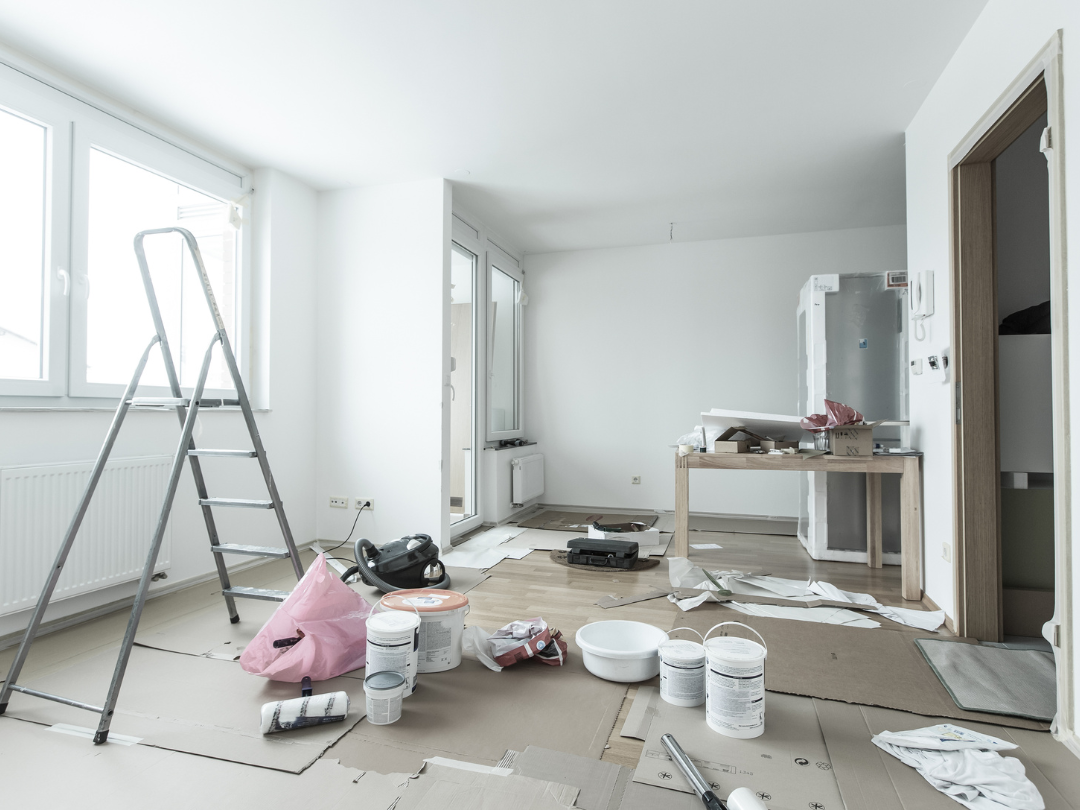Get the week's most popular posts delivered to your inbox.
Our weekly update is free yet priceless and you're less than a minute away from getting the current edition.
In the unlikely event we disappoint, you can unsubscribe with a single click!
Last Updated on August 14, 2024 by teamobn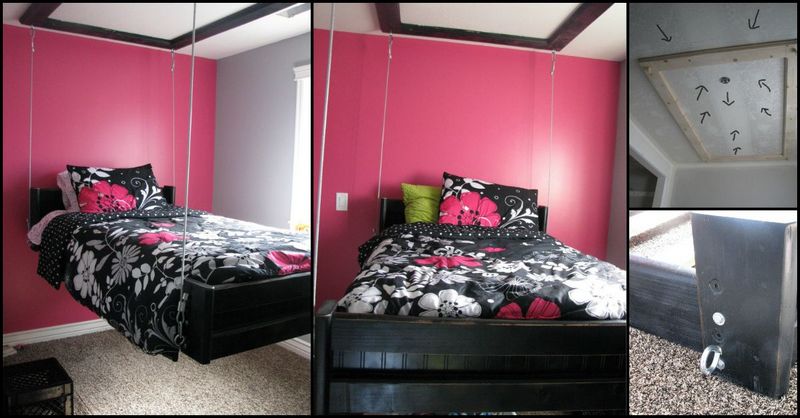
Who hasn’t enjoyed a lazy summer nap on a porch swing or in a backyard hammock? If only you could only re-create that easy, sweet, lazy feeling in your own bedroom.
Well, if you want to wake up to the reality of a hanging bed, this is definitely a project for you!
This bed is especially great for the kid’s bedroom. Its cables can carry up to 1500 lbs each. And with a hanging system similar to that of a bungee system, this bed is 100% safe to sleep on!
A hanging bed is a single bed that, instead of being attached to a frame, is simply suspended from the ceiling. It allows you to have a lot of flexibility when it comes to using your bed.
Instead of a bed that takes up a lot of room, you can have a bed that takes up little to no room at all. This is good news for both small houses, apartments and dorm rooms.
Even if you have a large bed and room in your current home, you can set up a hanging bed in an alternative space, such as a loft or basement, and then move the bed back when you need it. You can take it out of the space and then set it back up when you want to use it.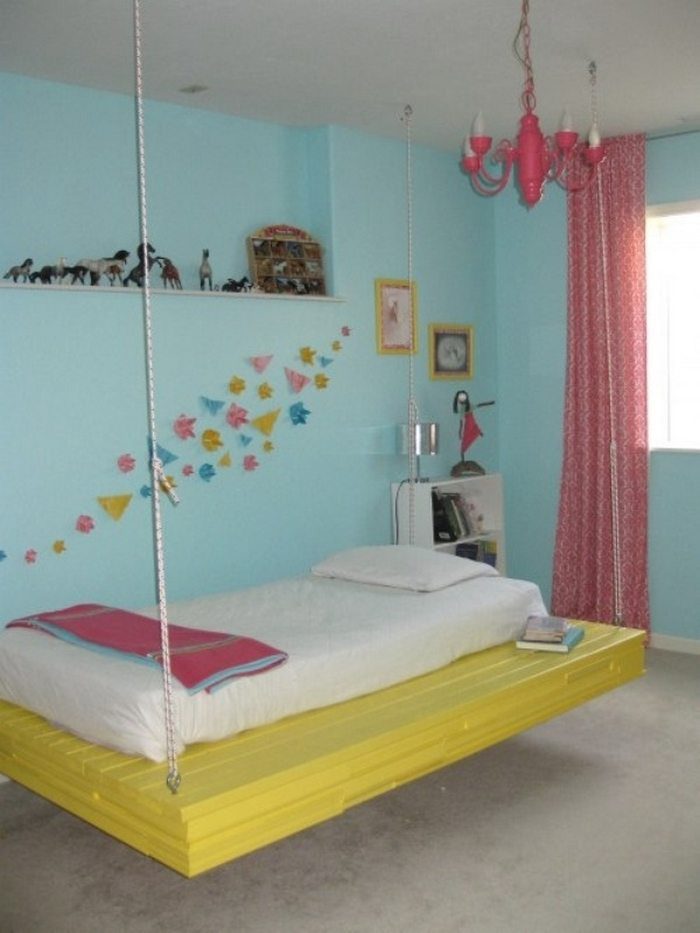
There are several advantages that hanging beds have over traditional beds. First, the fact that they hang on the wall means that there is no need for a bed frame, which can take up a lot of room.
Hanging beds also don’t need a box spring or heavy metal frame and can be hung from the ceiling, making it possible to offer a guest bedroom in an apartment where there is no room for a traditional bed.
Its gentle swing could rock you to sleep. As a bonus, cleaning under the bed would be much easier!
Hanging Bed Ideas
Double Deck Hanging Bed
The concept of the Double Deck Hanging Bed is a simple one. Beds are swung out from either side of a bunk bed. This gives you a lot more room in your bedroom. You also get more sleeping space. Both beds have their own headboards.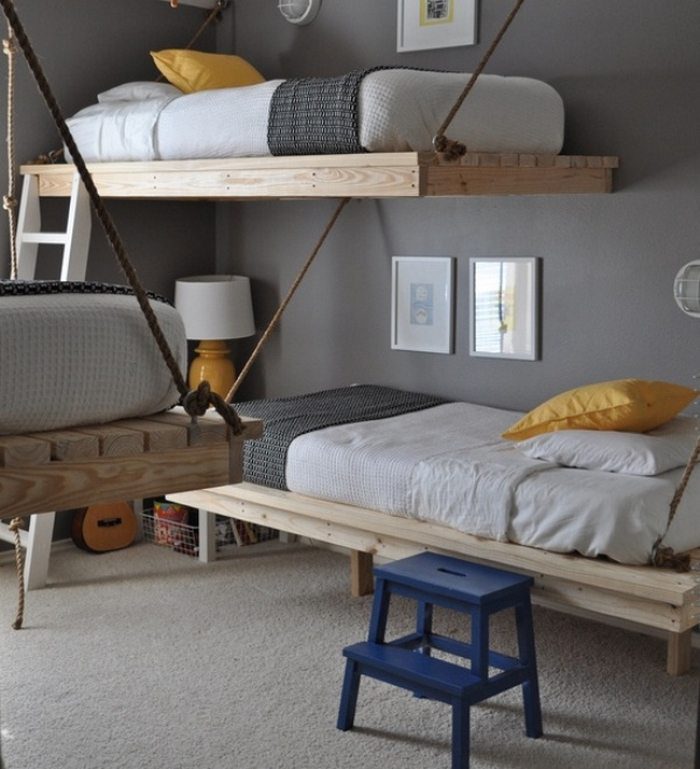
In the past, the only way to add more beds to a room was to buy more bed frames and mattresses. Hanging beds give you more flexibility. If you want to sleep two people in one room, you can put a twin hanging bed and a twin mattress on the floor below.
Or you can put two twin hanging beds on the same floor and still have room for a desk below. You can even put a twin-hanging bed on the bottom and a queen on top.
Hanging Boat Bed
The hanging boat bed is a popular choice for children who love boats. If you have a child who dreams about being a captain, or if your child loves to read about boats and sea adventures, this hanging boat bed can be a great décor choice.
Hanging boat bed designs are important for children who love to sleep in boats. Hanging beds are in fact ideal for many types of children and adults. In addition, for families with limited space, hanging beds can make space greater utilization.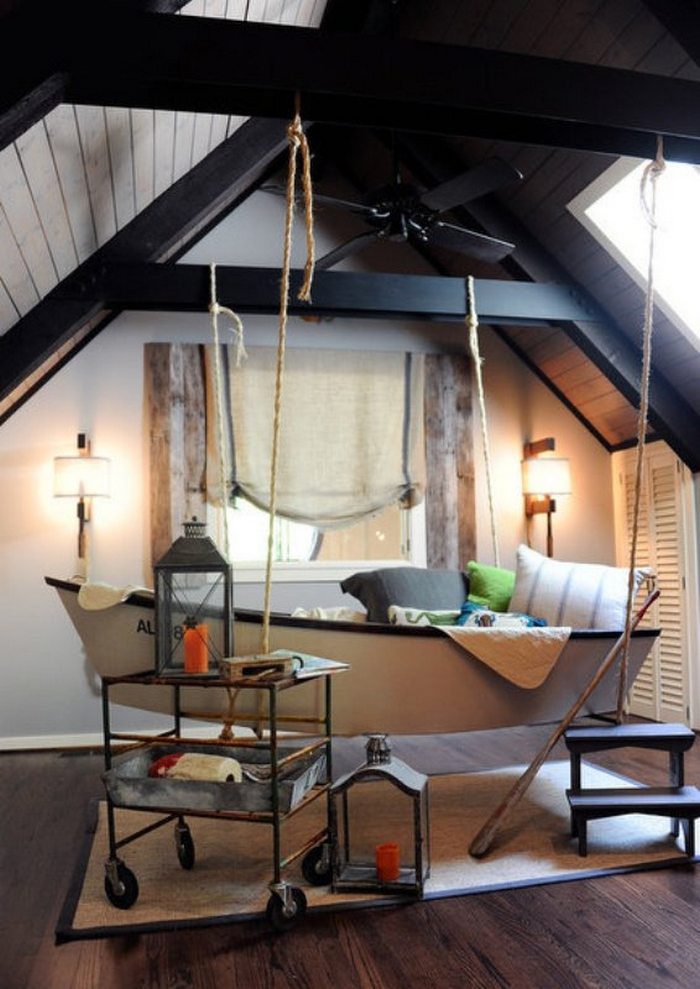
Building a Hanging Bed
Materials
- 2×6 Timber
- Eye Bolts
- Gorilla Glue
- Nuts and Washers
- 4″ Lag Screws
- Spray Paint (optional)
- 1/4″ Ferrule & Stop Set
- Steel Cable
- Quick Link Hardware
Tools
- Circular Saw
- Drill
- Measuring Tape
- Stud Finder
Instructions
Step 1: Design and Measurements
- Measure the space where you want to install the hanging bed to determine the size of the bed frame.
- Cut the 2×6 timber using the circular saw to create the frame. Typically, a full-sized bed frame would require two pieces at 75 inches and two pieces at 54 inches for the sides.
Step 2: Frame Assembly
- Lay out the timber to form your rectangle or square frame depending on the size of your bed.
- Use the drill to create holes at each corner and apply Gorilla Glue before fastening with lag screws and washers to reinforce the frame’s corners.
Step 3: Preparing the Support System
- Determine the number of eye bolts needed based on the frame size (usually one at each corner and optionally at mid-points for added support).
- Drill holes for the eye bolts into the frame. Ensure they are evenly spaced and aligned.
- Screw the eye bolts into place, securing them with nuts and washers on both sides of the timber.
Step 4: Painting the Frame (Optional)
- If desired, paint the frame with spray paint. Let it dry completely before proceeding.
Step 5: Installing the Ceiling Supports
- Use the stud finder to locate ceiling joists where the bed will hang.
- Drill holes into the ceiling joists and install eye bolts, securing them with nuts and washers.
- Make sure the eye bolts are strong enough to support the combined weight of the bed and occupants.
Step 6: Attaching the Cables
- Cut four lengths of steel cable to reach from the ceiling to the bed with some extra length for adjustments.
- Thread each cable through an eye bolt on the frame, then use the ferrule and stop set to create a loop at the end of each cable.
- Attach each cable to the corresponding ceiling eye bolt using quick link hardware. Adjust the length of the cable to ensure the bed hangs evenly.
Step 7: Final Adjustments and Safety Check
- Double-check all connections, nuts, and bolts to ensure everything is tightly secured.
- Test the bed by applying gradual weight to ensure stability and safety.
- Adjust the height of the bed by shortening or lengthening the cables as necessary.
Step 8: Adding a Mattress and Bedding
- Place your mattress on the frame.
- Add bedding, pillows, and any other decorative items to create a comfortable and inviting hanging bed.
Click on any image to start lightbox display. Use your Esc key to close the lightbox. You can also view the images as a slideshow if you prefer 😎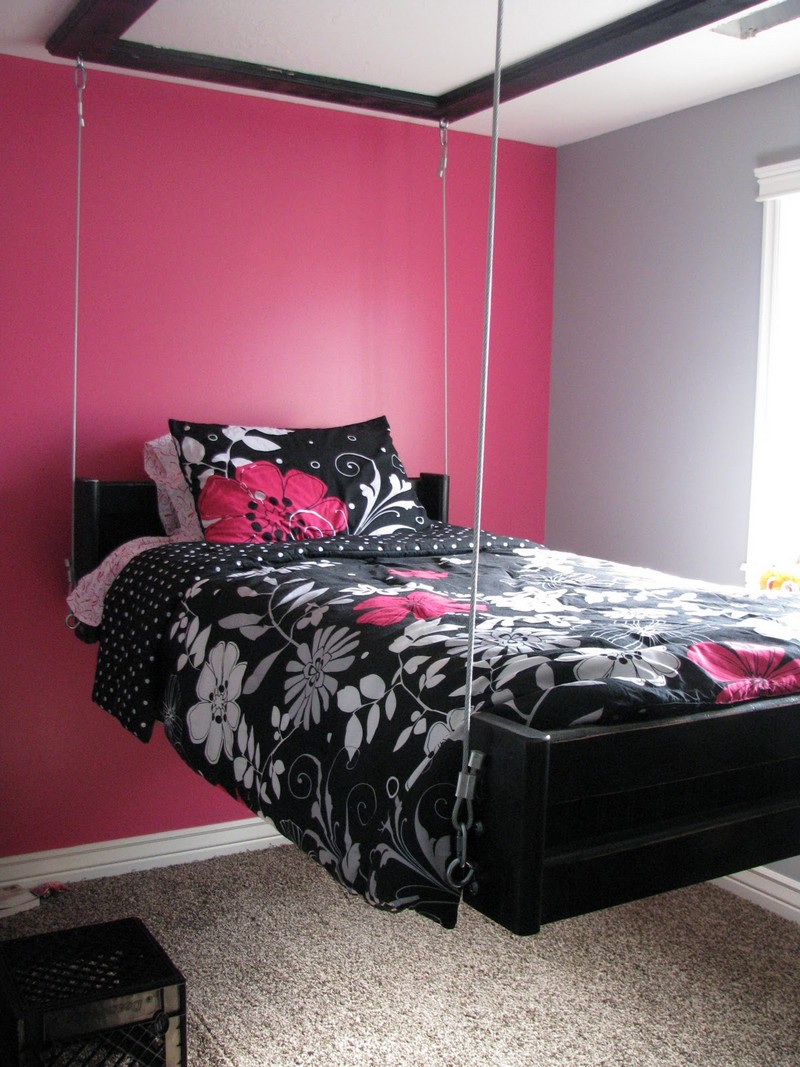
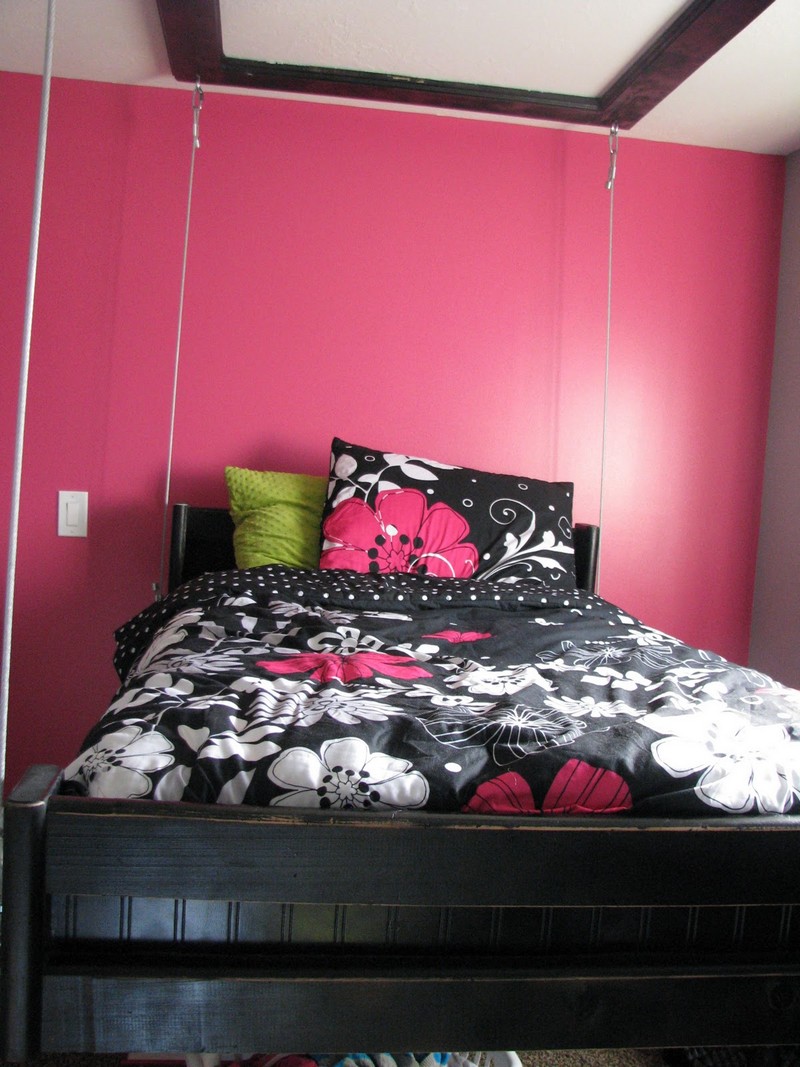




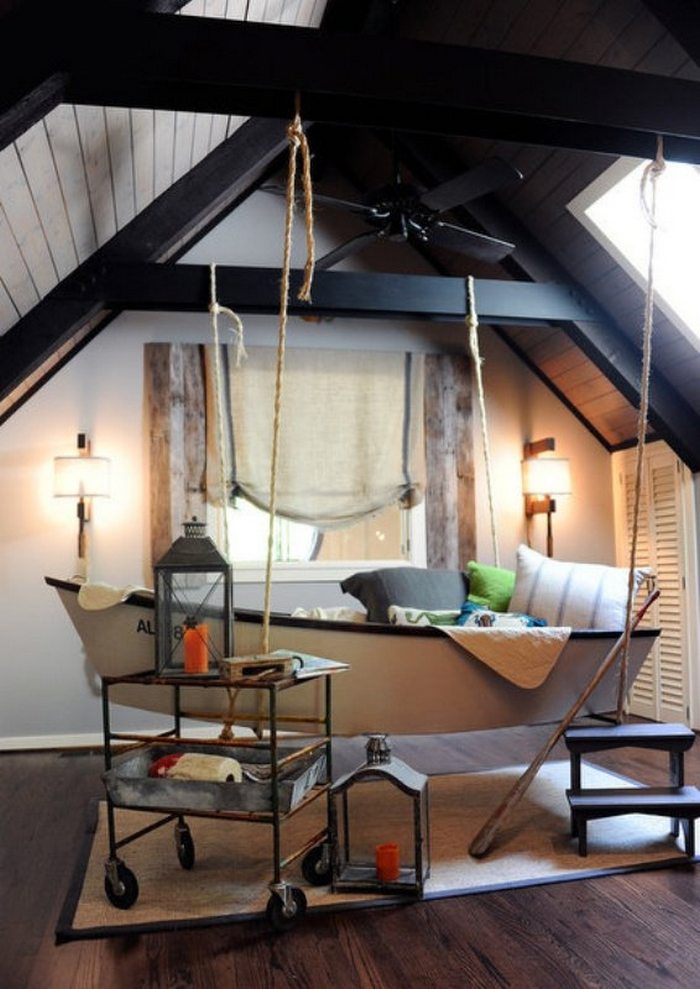
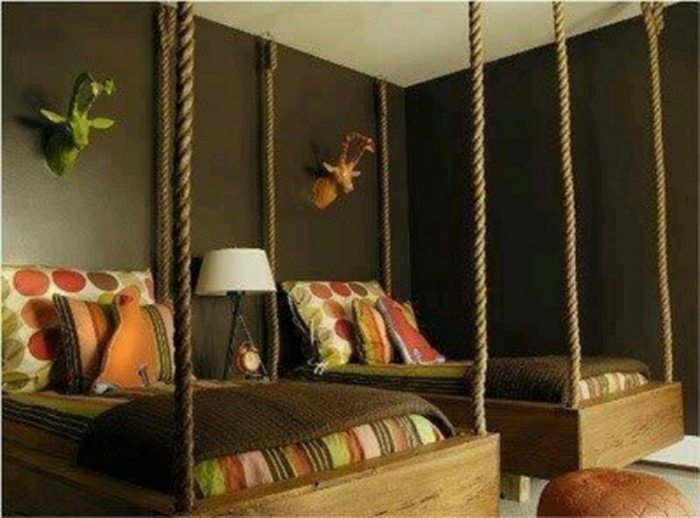
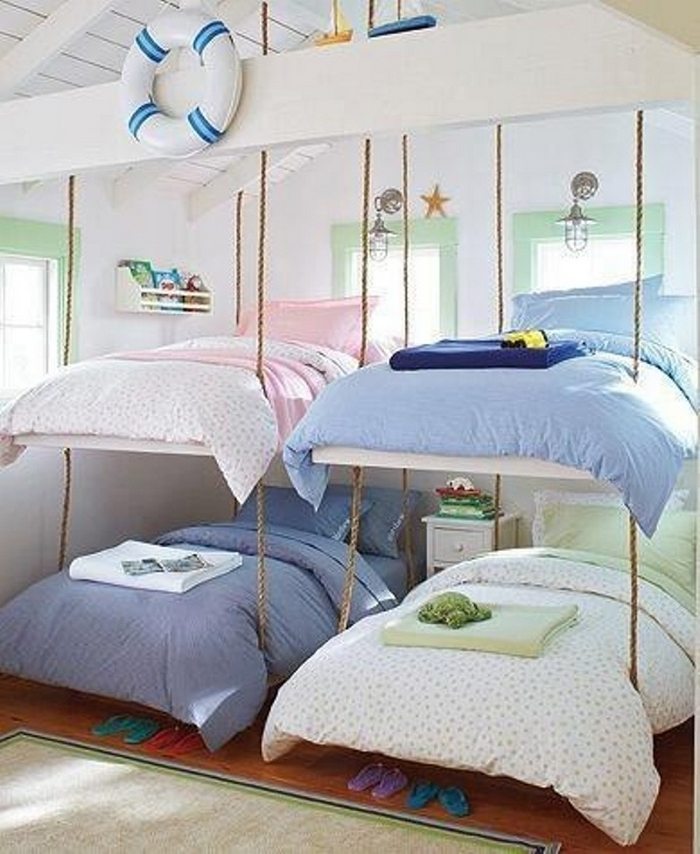
You can get more step-by-step instructions here…
Safety and Installation Tips
When it comes to installing a hanging bed, ensuring the safety and stability of your setup is paramount. A hanging bed not only adds a unique aesthetic to your space but also requires careful consideration during installation to ensure it can securely support weight and withstand regular use.
Below are detailed safety and installation tips to guide you through setting up your hanging bed safely.
Choose the Right Location
- Evaluate Structural Integrity: Before installing a hanging bed, assess the structural integrity of the ceiling where it will be mounted. It’s crucial to confirm that the ceiling can support the combined weight of the bed, the mattress, and the occupants. Consulting with a structural engineer or a professional installer can provide valuable insights and prevent potential hazards.
- Select an Appropriate Space: Ensure that the chosen location allows for ample space around the bed for safe access and movement. Avoid areas where doors, windows, or furniture could interfere with the bed’s swing or create a safety hazard.
Use High-Quality Materials
- Select Durable Hardware: Choose high-quality, durable materials for all components of the hanging bed. This includes using heavy-duty eye bolts, steel cables, and robust mounting hardware that are specifically rated for weight much higher than the expected load.
- Opt for Strong Timbers: When building the bed frame, use strong timber such as 2x6s or thicker, depending on the size and expected load. Ensure that the wood is free from cracks and defects that could compromise its strength.
Secure Installation
- Install into Ceiling Joists: When installing the eye bolts in the ceiling, make sure they are securely screwed into the ceiling joists and not just the plasterboard or drywall. Use a stud finder to locate the joists accurately.
- Double-Check All Connections: After installing the eye bolts, cables, and other hardware, double-check all connections. Ensure that all nuts and bolts are tightened and that cable loops are securely fastened with ferrules and stop sets.
- Test Before Use: Before placing a mattress on the frame, test the hanging bed by applying gradual weight to the bed to ensure it can hold the weight without any issues. Check for any signs of strain on the ceiling or the bed frame.
Safety Checks and Maintenance
- Regular Inspections: Regularly inspect the hanging bed for any signs of wear, loose fittings, or damage. Check the condition of cables, bolts, and the bed frame to ensure everything remains tight and intact.
- Maintenance of Moving Parts: Periodically check and lubricate any moving parts like quick links or carabiners that are used to attach the cables. This prevents rusting and ensures smooth movement.
- Monitor for Noise and Movement: Pay attention to any unusual noises or excessive movement. These could indicate that adjustments are needed or that some components are wearing out and may need replacement.
Educate on Usage
- Provide Clear Instructions: If the bed is intended for use by children or guests, provide clear instructions on how to safely use the hanging bed. Make them aware of any limitations in weight or movement to prevent misuse.
- Limit Rough Usage: Advise against rough use, such as jumping or swinging aggressively on the bed, as it could destabilize the installation and lead to accidents.
Installing a hanging bed requires meticulous attention to detail and a commitment to safety. By following these guidelines, you can ensure a secure installation that provides both comfort and peace of mind, making your hanging bed a safe and cherished addition to your home.
Conclusion
With their soft sway, hanging beds provide a distinctive and fashionable accent to any house that helps to turn plain areas into comfortable havens. Apart from saving space in small rooms, they offer a unique sleeping experience that one can adjust to fit personal preferences. A hanging bed transforms from a functional piece of furniture combining aesthetics with utility depending on the materials and installation technique.
If you liked this project, you will also like viewing these swings and hammocks…
Get the week's most popular posts delivered to your inbox.
Our weekly update is free yet priceless and you're less than a minute away from getting the current edition.
In the unlikely event we disappoint, you can unsubscribe with a single click!





